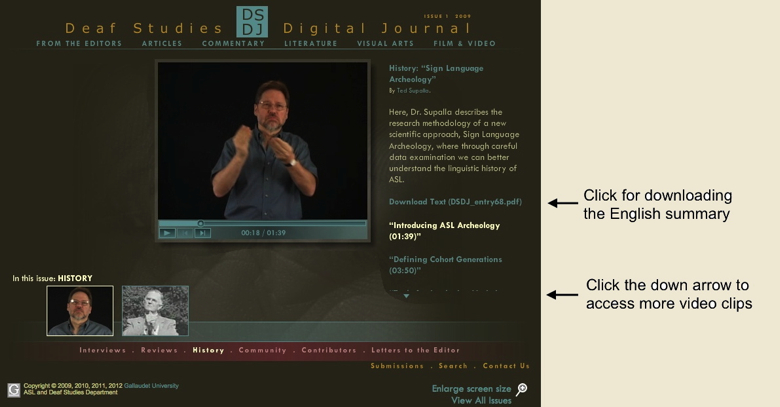Publications on Historical Linguistic Research
Ongoing research has shown that the sign language in historical sign language films produced by the National Association of the Deaf reflects a formal elite register of ASL used at the time, a variety that is valid for the study of ASL historical form.
Further research based on this recognition is described in a new text on historical change in ASL in the social context of the early 20th century American Deaf Community. This text is “Sign Language Archeology: Understanding the History of ASL”, by Ted Supalla and Patricia Clark, due to be released in March 2015, by Gallaudet University Press.
Two lists of our other published articles on historical linguistic research on ASL are given below.
Electronic articles in ASL
A series of articles in the Deaf Studies Digital Journal by Ted Supalla and research assistants describes the methodology and provides examples of historical reconstruction establishing etymological relationships between early and modern signs. The link to the full article in ASL, with access to an English summary is given below for each article, along with the article title and a description of its topic. Below this information, a list of the individual video clips for the sections of each article is given, along with the viewing time for that section.

Sign Language Archeology-Ted Supalla, 2009
Video 1: Introducing Sign Language Archeology (01:39)
Video 2: Defining Cohort Generations (3:50)
Video 3: Tools for Analyzing Variation (4:00)
Video 4: Integrating Synchronic and Diachronic Approaches (3:49)
Video 5: Digging On Your Own (1:21)
Video 6: Data: NEVER (00:37)
Video 7: Data: STARS (00:21)
Video 8: Data: WATER (00:33)
Video 9: Data: WHO (00:29)
Video 10: Acknowledgements (1:30)
Using Etymology to Link ASL to LSF- by Ted Supalla 2010
Video 1: Recognizing Folk Etymology (5:15)
Video 2: Integrating Etymological Sources (1:48)
Video 3: Seeking the French Connection (6:04)
Video 4: Revealing Periodic Reanalyses (3:18)
Video 5: ‘Thumbing’ through the Sources (9:54)
Video 6: Accommodating the Outliers (2:09)
Video 7: Contributing Etymologies to Sign Language Archeology (2:39)
Guidelines for the Study of ASL Etymology- by Ted Supalla 2012
Video 1: Introduction- “A Field Guide Companion for ASL Etymology” (00:35)
Video 2: Scrutinizing Etymological Sources (3:32)
Video 3: Sizing up the French Connection (2:25)
Video 4: Ruffling FATHER’s Feathers (3:10)
Video 5: Alternative Connections (3:17)
Video 6: Change across Multiple Contexts (3:32)
Video 7: FACE Hidden in Plain Sight (4:50)
Video 8: The Gift of Knowledge (3:58)
Video 9: Lexicography and Homonymy (4:37)
Video 10: Flaws in Lexicography (3:15)
Video 11: Contextual Restraints on Reduction (2:39)
Video 12: Etymological Development in Context (3:48)
Video 13: Summary of Guidelines (1:29)
Tracking our Sign Language Heritage- by Ted Supalla, Matthew Malzkuhn, and Fanny Limousin, 2014
Video 1: Illuminating a 250-year legacy (2:49)
Video 2: The early 20th century sign language campaign (6:50)
Video 3: Further documentation in the 20th Century (2:43)
Video 4: Preserving Deaf folklife films (2:58)
Video 5: Creating a historical film database (3:05)
Video 6: Interpretation of Deaf values in films (6:11)
Video 7: Reconstruction and reenactment of historical signs (4:49)
Video 8: Before the beginning: LSF in France (2:46)
Video 9: The First 50 years of LSF Documentation (2:31)
Video 10: The Etymology for MAN in LSF (4:09)
Video 11: The constructions for BOY in LSF (4:28)
Video 12: The history of ideas in the Deaf Community (5:30)
Video 13: Community epistemology in the NAD films (4:24)
Video 14: Framing ASL as a heritage language (2:22)
Printed articles in the English language on historical linguistics
Supalla, Ted. (2001). Making historical sign language materials accessible: A prototype database of early ASL. Sign Language and Linguistics, 4, 285-297.
Supalla, Ted. (2004). The validity of the Gallaudet Lecture Films. Sign Language Studies 4: 261-292.
Supalla, Ted. (2008). Sign language archaeology: integrating historical linguistics with fieldwork on young sign languages. In R. M. de Quadros (Ed.) Sign Languages: spinning and unraveling the past, present and future. TISLR9, forty-five papers and three posters from the 9th Theoretical Issues in Sign Language Research Conference, Florianopolis, Brazil, December 2006. Petropolis: Editora Arara Azul. (PDF)
Supalla, T. & McDonald, Betsy Hicks. (2011) Building an infrastructure to support historical sign language research. Minpaku Anthropology Newsletter, No. 33, National Museum of Ethnology, Osaka, Japan. (PDF)
Supalla, Ted. (2013). The role of historical research in building a model of sign language typology and variation. Kikusawa, Ritsuko. and Reid, Lawrence. (Eds.) The Proceedings of the International Conference of Historical Linguistics 20, 15-42. The Hague: John Benjamins.
Supalla, Ted and Clark, Patricia. (2